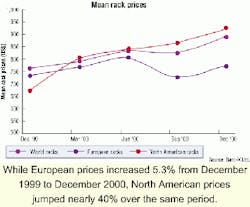Severe collocation cramp exists in North America
The cost of carrier-neutral collocation in the U.S. is higher than in Europe for the first time-here's why.
TIM ANKER, Band-X Ltd.If you've bought carrier-neutral collocation space in North America recently, chances are you've been paying up to 40% more than a year ago and considerably more than your European counterparts. This price hike shows little sign of slowing as the price of collocation in North America is rising about six times faster than in Europe.
This gap in prices first became apparent last year. A survey of the prices on the Band-X collocation trading floor showed that for the first time, it was more expensive to house equipment in a carrier-neutral collocation facility in the United States than in Europe. Before the year 2000, the reverse was usually the case, with space in U.S. collocation facilities being significantly lower than across the Atlantic.
Looking ahead, the collocation market should certainly be tracked closely. We are already seeing consolidation taking place with several companies cutting back their business plans in line with funding requirements. And as carriers feel the pinch too, they are increasingly opting to outsource collocation.
A collocation facility is a secure, specialized building where telecommunications companies can house the equipment needed to run their networks and interconnect with each other. A "fully serviced" building comes complete with the power, fire control, air conditioning, and other features vital to house the equipment, which is mounted in standard-sized racks.
In June 2000, the price of a rack in a fully serviced facility averaged $840 per month in the United States, 20% more than six months previously. A similar rack in Europe cost around $800 per month, a rise of 4% over the previous six months.
Three months later, the situation hadn't changed much, according to Band-X's prices. A single rack in the U.S. cost on average $864 per rack per month, compared to $726 in Europe, some 20% higher.
And this trend has continued in 2001. At the start of the year, a rack in the U.S. cost as much as $924 per month, up 7.5% in the last quarter. In Europe, that same rack would cost around $771 per month, or about 16% less. Although European rack prices displayed a comparable increase of 6% over the last quarter, the rise in prices over the last year is truly telling (see Figure). The Table shows that the average collocation price per rack per month in Europe for the period December 1999 through December 2000 increased 5.3%, while in North America, collocation costs were up 38.2%.
The most important reasons for these differences in price have to do with the amount of carrier-neutral collocation being built and the typical size of these facilities on the two continents. Price stability in Europe has been helped by the rapid construction of a number of large facilities.
Typically, European build-outs remain significantly larger than those in the United States. Halfway through 2000, the typical size of a U.S. facility was around 1,900 sq m, or less than half the size of an average European build. Three months later, this collocation cramp had become even more severe.A further survey of the size of facilities posted on the Band-X trading floor revealed that the average European facility was nearly four times the size of its U.S. counterpart. According to postings on the Website, the average European facility stood at more than 4,800 sq m, compared with 1,297 sq m in the U.S. This difference in size appeared to be a major factor in the continuing price differences between the two continents: At this point, U.S. prices were 20% higher than European prices.
At the beginning of 2001, collocation cramp in the U.S. started to ease-slightly. However, despite several new larger facilities coming on stream in the U.S., the average European facility was still three times larger than its U.S. counterparts, and the prices charged for rack space in the U.S. remain significantly higher.
Indeed, facility sizes in both Europe and North America increased over the last quarter of 2000. But in the U.S., increases were almost 40%, with the average facility size up from 1,300 sq m in the third quarter of 2000 to 2,100 sq m by the end of the year. Despite this jump, the average size in Europe remained comfortably larger: Over the same period, the average size of European collocation facilities on the exchange increased by just over 10% from 4,867 sq m to 5,368 sq m.
It is worth noting that in the last quarter of 2000, every single new entrant to the market entered with facility sizes greater than the average facility size. Not only did these companies come in with big facilities, but new entrants also aimed to charge a premium-nearly every new player's rack prices were above the fourth quarter 2000 average.The most significant issue in collocation over the next year will not be price, location, or facility size, but rather the question of power.
The trend toward increasingly sophisticated Web-based hosting within collocation space is pushing up power requirements substantially.
The amount of kit being housed in collocation facilities is increasing, while at the same time, the size of the kit itself is shrinking, meaning more kit is being packed into smaller areas. That has two main effects: More power is required than ever before for the same area, and more heat is generated, which in turn requires additional cooling, with the air conditioning creating an added need for power.
It is estimated that about 2,000 V/sq m is required by collocation. And so, power is almost more of a driver as to where collocation is built than network availability, as collocation providers follow the power supply across national grids. Two other trends of note:
- After a slow start, carrier-neutral collocation space is becoming available in the Asia-Pacific region and in Latin America.
- Tier two and three locations will start to grow in significance as content is pushed to the edge of the network. Already, there is an increase in activity in these areas.
As U.S. collocation providers are scrambling to keep up with an increasingly buoyant market, it is worth exploring the historical differences between the U.S. and European collocation market that led to these disparities.
Increasingly, collocation facilities in Europe are located in the industrial areas away from the urban centers, where space is available and ground rents are lower. London's Telehouse, the grand dame of collocation, and the surrounding Docklands development is a case in point. But surprisingly, this trend is still being resisted in the United States.
There is a continuing trend toward city center collocation in the U.S. But many city centers simply don't have the large buildings needed for collocation available. Since a prime factor determining the quality of a collocation building is the number of other carriers within the same building, the desire to stay in the center is self-perpetuating. Eventually, that will have to change: A carrier is going to need a big chunk of collocation space, and collocation facilities are going to have to move out of the city.
In addition, the price squeeze in the U.S. over the last year reflects the fact that the North American collocation market has traditionally been driven by the real-estate sector-if a buyer wanted fully fitted space, that carrier would go into a building and do the fit-out themselves.
Today, because build-out time is so critical, the off-the-shelf solution offered by collocation providers is becoming much more attractive; the market simply hasn't been able to match this demand, hence the price rises. The carrier-neutral collocation market continues to evolve at an unbelievably fast pace, with more and more facilities emerging all the time, while those that are rapidly built fill up. Indeed, many facilities are sold before the facility is even finished.
There are large builds taking place in first-, second-, and third-tier markets and in both traditional and nontraditional marketplaces in the U.S. The high demand, however, makes it difficult to predict when U.S. collocation price increases may flatten out.
Looking ahead, it is likely that some of the early entrants into the European markets-companies that saw collocation as an opportunistic adjunct to their main business-will start to feel the heat as the specialist companies come on stream. Consolidation already is underway, and players are paring down business plans in line with reduced funding, leaving the field open for well-funded players like Global Switch, Redbus, and IXEurope. These companies are set to change the shape of the European market.
While supply may become less certain over the following months, underlying demand for collocation is expected to remain strong, as carriers begin outsourcing their collocation rather than building their own facilities. In addition, even though demand from startups is waning, the corporate sector will become an important collocation customer.
Tim Anker is vice president of global collocation trading at Band-X, the bandwidth exchange headquartered in London. He can be reached at the Band-X collocation Website, http://www. band-x.com/colocation.cfm.



